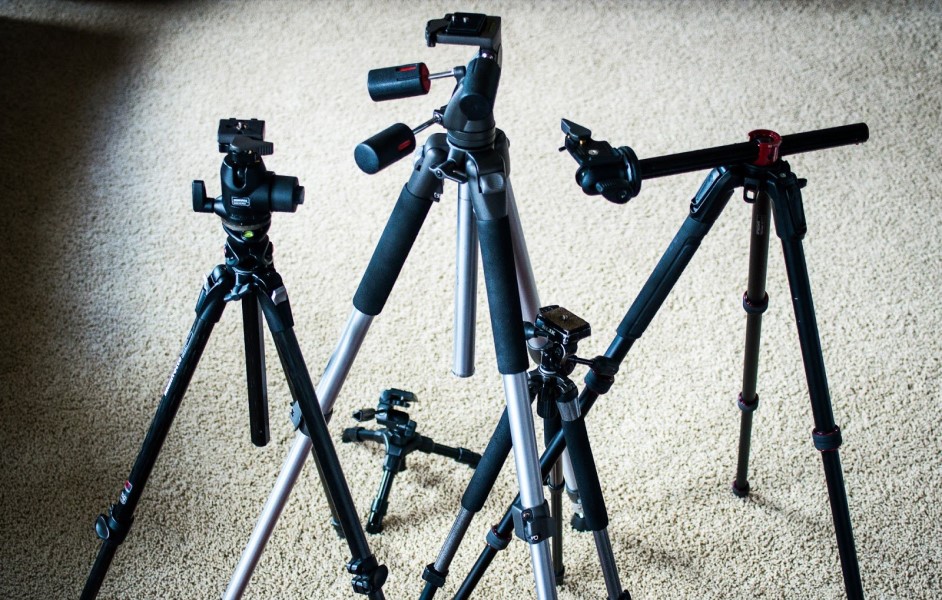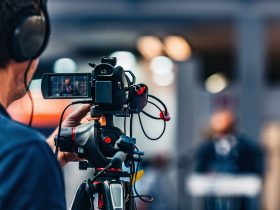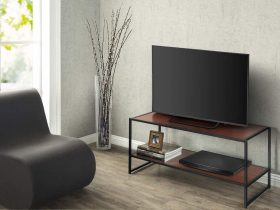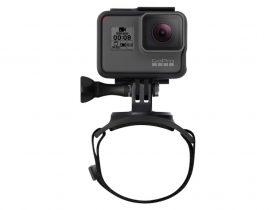Do you need a bit of extra stability when taking photos? A tripod could be the answer. So which is the best tripod for DSLR?
As a travel photographer, I’ve realized that a reliable tripod can often be more important than an additional lens. Carrying a tripod is never fun but the results you can achieve really make up for the extra effort it takes to carry one.
Handheld shooting is easier than ever before thanks to vibration reduction and stabilizing features in modern cameras. But if you want to capture star trail motion blur, timelapse videos, or long exposures, a tripod is an essential piece of kit.
The best tripod for DSLR cameras will be lightweight but sturdy. It should allow you to shoot from a variety of angles while keeping your camera steady.
I have collected 10 products that you should find useful. So let’s take a look.
Best Tripod For DSLR Cameras
K&F Concept 62-inch DSLR Tripod

Material: Aluminum | Leg sections: 4 | Max load: 10kg | Max height: 157cm | Folded height: 45.5cm | Weight: 1.1kg | Leg lock type: Flip
If you are in search of a multi-purpose tripod that will not break the bank, the K&F Concept 62-inch tripod could be the one for you.
It offers a great set of features for both beginners and more advanced photographers, all for a very attractive price. Its 4-section legs have twist locks that make the set-up process fast and effortless. Its maximum height is 157cm, and it can go as low as 40 cm.
The K&F concept tripod can support cameras and lenses of up to 10kg in weight, an impressive amount considering its cost of it. Plus, it comes with a ball head that provides smooth omnidirectional movement for the camera.
Framing your subjects is fast and easy, thanks to the 2 screws that let you twist and turn your DSLR as you prefer.
Finally, if this wasn’t enough, this tripod also has a mobile mount, enabling you to shoot film with your smartphone.

Material: Aluminum | Leg sections: 5 | Max load: 3.5kg | Max height: 144cm | Folded height: 37.5cm | Weight: 1.5kg | Leg lock type: Flip
The Vanguard VEO 235AP boasts patented column rotation, so you can set up and shoot in a matter of seconds.
This tripod features convertible feet that allow you to safely position your camera on any type of terrain. Simply add the spikes, and you’ll be set for shooting on slippery or uneven ground.
As for ergonomics, this tripod has a large rubber handle that provides an excellent grip in any weather conditions.
It also has a 2-way PH-25 pan head with a bubble level, a large screw to adjust the head, and a handle to guide your camera, composition is simple and fast.
At 1.5kg, the VEO 235AP is lightweight to carry around, and with a load capacity of 5kg, it can support most DSLR kits.
Considering the price point, this tripod could definitely be called the best tripod for DSLR.
Oben CT-3535

Material: Carbon fiber | Leg sections: 5 | Max load: 4.1kg | Max height: 131cm | Folded height: 30.5cm | Weight: 1.1kg | Leg lock type: Twist
The Oben CT-3535 folding carbon fiber tripod offers exceptional performance for a great price.
Its folding size is just 30cm thanks to its 5-section legs, meaning that it will be as easy to carry as a water bottle on the side of your backpack. It reaches a maximum height of 131cm, which is slightly lower than other tripods, but sufficient for most situations.
If you shoot macro photography, the Oben CT-3535 can operate from a height of just 20cm above ground, allowing you to get creative with low-angle shooting.
The tripod’s legs are separate and can be adjusted independently to 3 different angles, creating countless opportunities for shooting from different surfaces. Plus, if you need additional stability, the rubber feet come with integrated spikes.
Joby Gorillapod Focus

Material: Stainless steel and plastic | Leg sections: 1 | Max load: 5kg | Max height: 31cm | Folded height: N/A | Weight: 1.3kg | Leg lock type: N/A
While traditional tripods all tend to function in a similar manner, the Joby Gorillapod Focus is truly revolutionary.
While it cannot stand at eye level on its own, this small but strong tripod can be mounted virtually anywhere, thanks to its multi-segmented legs.
Its legs can twist and rotate 360 degrees, and although it may not appear sturdy, it can support up to 5kg of weight.
You can attach it to tree branches, fences, or doorknobs and you can photograph and record videos from perspectives unreachable by other tripods.
The Gorillapod Focus weighs about 1.3kg and fits into most camera bags. Its legs are made of stainless steel and plastic, making them flexible yet extremely durable. The feet are also rubberized and offer a good grip if you choose to position it on the ground.
Manfrotto MKBFRA4-BH Befree

Material: Aluminum | Leg sections: 3 | Max load: 4kg | Max height: 144cm | Folded height: 40cm | Weight: 2.4kg | Leg lock type: Flip
You can’t really go wrong with Manfrotto. Among the huge selection of tripods this brand has to offer, the MKBFRA4-BH BeFree stands out thanks to its price, ease of use, and durability.
The compact design makes this tripod portable and perfect for travelers. Its legs fold up around its top, reducing bulk without compromising maximum height.
From 40cm folded, the BeFree goes up to 144cm. The legs can be moved independently from each other, however, the feet are not interchangeable.
The BeFree can support up to 4kg of equipment, making it suitable for heavier cameras.
The ball head is flexible and can be adjusted rapidly thanks to the side screws with an ergonomic design.
Ideal for both street photographers and city dwellers, the Manfrotto BeFree is a reliable choice for both beginners and advanced photographers.
Sirui T-025SK Carbon Fiber Tripod

Material: Carbon fiber and magnesium alloy | Leg sections: 5 | Max load: 5kg | Max height: 130cm | Folded height: 31cm | Weight: 1kg | Leg lock type: Twist
With a removable center column and 180-degree folding legs, the Sirui T-025SK carbon fiber tripod offers maximum versatility in a compact size.
This tripod can be collapsed to just 30cm, allowing you to carry it anywhere.
The removable center column can be inverted to shoot from almost ground level. If getting creative with new perspectives is your thing, the 5-section legs let you adjust them independently to adapt to any surface or terrain.
A keyring and a carabiner are on the bottom of the center column, in case you need to add weight to increase stability.
The Sirui tripod can hold up to 5kg of weight and comes with cold-weather grips that are perfect if you plan to shoot in freezing winter climates.
3 Legged Thing Equinox Leo

Material: Carbon fiber and magnesium alloy | Leg sections: 5 | Max load: 30kg | Max height: 140cm | Folded height: 35cm | Weight: 1.7kg | Leg lock type: Twist
While the first thing you’ll probably notice is the futuristic look of the 3 Legged Thing Equinox Leo, its design doesn’t stop at aesthetics.
This sturdy tripod performs exceptionally well in any situation, both because of its strength and its flexibility.
It is able to support up to 21 times its weight, which makes it one of the sturdiest DSLR tripods out there. At the same time, it is fairly compact, collapsing to just 35cm.
The unique feature of the 3-Legged Thing Leo is that its legs are not connected and can be adjusted individually, so you can regulate the tripod to suit any surface or shooting angle.
But a standout feature is that you can transform it into a monopod and use the other legs to hold extra gear, such as a microphone or lights.
Another advantage of the Leo is the variety of options in terms of the tripod’s footwear. You can switch from rubber spikes to rubber balls at any time to suit the surface you are shooting on.
Really Right Stuff TQC-14 Series 1 MK 2

Material: Carbon fiber | Leg sections: 4 | Max load: 11.3kg | Max height: 149cm | Folded height: 44.9cm | Weight: 1.5kg | Leg lock type: Twist
The Really Right Stuff TQC-14 Series 1 MK 2 is an expensive piece of gear, but considering what is capable of, the price is justified.
Lightweight yet powerful, this tripod weighs just 1.5kg but is able to support over 11kg of equipment.
You can mount telephoto lenses on it without worrying about stability. Its maximum height is 149cm, which puts your camera at a standard eye level, and its packed size is 45cm.
What is interesting about this tripod, however, is its minimum working weight. The TQC-14 can be lowered to an impressive 8cm, allowing you to position your camera just above the ground and get that unique worm’s eye view.
It is fast to set up thanks to its twisting 4-section legs, which is great for street photographers who need to catch the moment.
And finally, the feet are rubberized and designed in a teardrop shape, reducing the contact area to the ground while maximizing grip.
Gitzo GK1545T-82TQD Series 1 Traveler

Material: Carbon fiber | Leg sections: 5 | Max load: 9.9kg | Max height: 116cm | Folded height: 42.5cm | Weight: 1.4kg | Leg lock type: Twist
The Gitzo GK1545T-82TQD Series 1 Traveler tripod really seems to have it all.
It is compact yet sturdy, capable of supporting over 9kg of weight. If you are looking for a portable tripod, the GK1545T-82TQD will provide the versatility you need without the bulk.
Balancing long telephoto lenses will not be a problem, thanks to their load capacity. However, it’s not just made for wildlife photography. This tripod can be lowered down to about 20cm, perfect for macro shots of still life or to get creative with unusual perspectives.
Made from carbon fiber, the GK1545T-82TQD is as lightweight as a tripod can get. Its 5-section legs fold into an extremely compact size without compromising on maximum height.
Additionally, the ball head fits perfectly between the legs and the feet are interchangeable, adapting to any type of terrain.
All of these features come at a price, but it is worth the investment if you are looking for a tool that will last and perform well in any situation.
How to Choose the Best Tripod for DSLR
While different tripods may look similar to one another, it’s the small details that make a huge difference in terms of performance.
Depending on what type of photographer you are, you’ll want specific features that will improve both your shooting experience and the quality of your images.
There are some key factors you need to consider before purchasing. These include:
- What will you photograph?
- Materials: Aluminum vs carbon fiber;
- Tripod weight;
- Maximum load capacity;
- Head type;
- Budget;
- Height; and
- Leg construction.
So let’s take a look at the main considerations to bear in mind when shopping for your next DSLR tripod.
What Will You Photograph?
Technology in modern cameras has improved so much in recent years that the risk of taking a blurry image is fairly low.
However, micro-vibrations produced by your hand are still impossible to avoid completely.
A tripod is not essential for all kinds of photography. However, if you plan to shoot at night, capture interior photography, experiment with long exposures, record timelapse videos or test your macro skills, you will need a tripod.
Aluminum vs Carbon Fiber
Both aluminum and carbon fiber offer good durability and weight, however, there are key differences you need to consider before buying.
Carbon fiber tripods absorb vibrations better and are usually much lighter. The downside? They tend to be more expensive than their aluminum counterparts.
Aluminum tripods are heavier, but they are also more budget-friendly and can last a lifetime.
Think about Tripod Weight
Weight is one of the most important factors to take into account if you intend to take your tripod on the road.
Full-size, professional studio tripods weigh about 3.5kg, which is not light, especially if you plan to walk around with it for hours.
Travel tripods are designed to be much lighter, often weighing less than 2kg.
Carbon fiber is the lightest material used for tripod legs, that’s why it is often preferred by outdoor or travel photographers.
Aluminum tripods are sturdy and while they are a bit heavier than carbon tripods, they are more durable.
Maximum Load Capacity
What equipment you will be mounting on your tripod?
When checking the load capacity, consider the weight of your DSLR body with its heaviest lens attached. If you use flashguns or microphones, this weight should be also taken into account.
The maximum load capacity should always be a bit higher than the weight of your heaviest gear set. This will ensure that your equipment is always secure and leave breathing room if you decide to upgrade your gear.
Tripod Head Type
The two most common types of tripod heads are ball heads and three-way heads.
A ball head is a type of support that is shaped like a sphere. It allows for 360-degree rotation of the camera and it is extremely compact.
Setting up a camera on a ball head is quick and easy. However, the main disadvantage is that they can require more time and attention when small and precise movements are required.
Three-way heads are larger and take more time to set up, as two knobs have to be adjusted to attach the camera.
They are better for making minor adjustments to the position of the camera and are more suitable for photographers who prioritize precision over speed.
What Is Your Tripod Budget?
There will no doubt be a limit to how much you can spend.
On top of stabilizing your camera, a tripod’s function is to secure your gear. The question to ask, therefore, is how much do you care about your equipment?
There are some great budget tripods that will work perfectly with basic camera equipment. However, if you own a massive telephoto lens, it is worth investing in something extra sturdy to ensure it doesn’t get damaged.
Tripod Height
There are three measurements to consider when it comes to tripod height: maximum and minimum working height, plus folding height.
When fully extended, a tripod should hold the camera at eye level, otherwise, you will have to bend to look into the viewfinder. Tall people should keep this in mind, as extended use of a short tripod is not great for the back.
The minimum working height determines how close to the ground a camera can get while mounted. This is important for macro photographers who want to capture small subjects (such as insects), for which a low angle is needed.
Folding height refers to the size of the tripod when it is collapsed. If you plan to carry the tripod in a backpack, make sure its folding height is small enough to fit.
Think about Tripod Leg Construction
The type of tripod legs you choose could be as important a decision as to the brand of tripod you choose. Let’s take a look at the different types.
Tripod Leg Sections
The legs of a tripod are composed of a number of separate parts called ‘sections’. Usually, the more sections a tripod has, the smaller its folding height.
The sections of a tripod’s legs collapse into each other, therefore a tripod with 5 sections is normally more portable than one with 3 sections. Although this is not always the case, so check the specs before buying.
The number of sections doesn’t only affect the folded height. A tripod with more sections will often be less sturdy, as the fragmentation of the legs offers less stability. This is especially important if you are shooting with long lenses, as even the smallest vibrations can cause blur in telephoto photography.
Tripod Leg Angles
In some tripods, the legs are connected to each other, and only their length can be adjusted individually. This offers greater stability, but it’s not ideal when shooting on uneven terrain.
Tripods with independent legs ensure greater flexibility, as they can be moved to suit any surface and they allow the camera to reach a lower shooting angle.
Is a Monopod Essential?
Many travel tripods can double as monopods when extra stability is not needed.
A monopod is essentially single-leg support for the camera. It still needs to be handheld, but can greatly reduce vibration and unwanted movements.
The advantage of using a monopod instead of a tripod is that it is faster to set up and is less intrusive. However, they are not suitable for long exposures.
Consider the Center Column
The central part of the tripod is where the camera is mounted. It can usually extend above the leg, adding that extra bit of height that may be needed to reach eye level.
In some tripods, the center column can be removed and mounted upside down, to allow for low-angle shooting.
In other models, the column can rotate, letting you easily adjust the framing positions.
Another useful feature of the center column is the hook that is sometimes found on its lower part. This is used to hang weights on the tripod. If you shoot in windy conditions or on a crowded street, adding weights to your tripod will reduce the risk of your camera falling or being knocked.
Do You Need Foot Spikes?
Rubber feet ensure great grip on most surfaces, but in some situations, these may not be enough.
Tripods with convertible feet allow you to add spikes to increase stability on slippery, wet, uneven, or soft ground.
Think Thermal Sleeves for Comfort
Tripods with thermal sleeves covering the legs are designed to protect your hands if you shoot in freezing temperatures.
Metallic materials can get extremely cold in winter. Having a layer of protection will allow you to move and adjust the tripod without gloves, even if you shoot in Arctic conditions.
Over to You
As you can see, there is a lot more to tripods than 3 legs and a support plate. We hope we’ve given you some inspiration when it comes to your next tripod purchase.
As with any other photography tool, tripod designs evolve over time. We’ll update this guide as new models are released, so make sure you check back from time to time.
Do you have a favorite DSLR tripod? Have we included it here? Let us know in the comments below.

















Leave a Reply